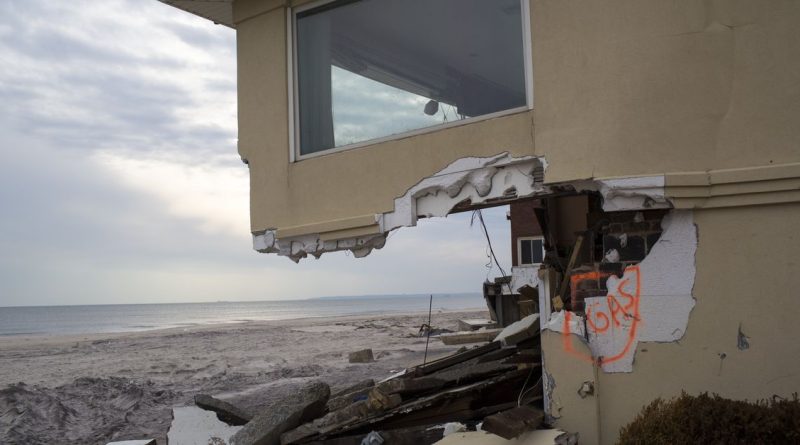Hurricane Sandy was much worse because of climate change, study finds
Just a few inches of human-driven sea level rise contributed to Hurricane Sandy’s devastation of the Northeastern US in 2012. Tens of thousands more people were affected, and more than $8 billion in damages incurred during the storm were a result of climate-induced sea level rise, according to a new study published in the journal Nature Communications.
That’s about 13 percent of the more than $62.5 billion total in damage that the superstorm created in New York, New Jersey, and Connecticut. Because climate change pushed sea levels higher, floodwaters were able to creep further inland — bringing more destruction with them.
This is the first study to put a dollar sign on how much human-caused sea level rise exacerbated damage during a storm, the researchers say. They hope their methods can reveal the vulnerabilities other coastal communities face as climate change pushes floodwaters closer to their doors.
“Sea level rise raises the launchpad for every single coastal storm,” says lead author Benjamin Strauss, a chief scientist and CEO of the nonprofit research organization Climate Central. “Climate change is already hurting us more than we realize. And hopefully, this research can help to inspire more investigation into just how much.”
Waters surrounding the New York area rose by roughly four inches in the 100 years before Hurricane Sandy made landfall. As a result, floodwaters reached about 36,000 more homes and 71,000 more people, according to the study conducted jointly by Climate Central and other researchers from the Stevens Institute of Technology and Rutgers University.
Hurricane Sandy was one of the costliest storms to strike the US. At least 147 people in the US lost their lives, according to the National Hurricane Center. Nearly a decade later, others are still recovering from the damage inflicted on their homes by the storm. Parts of the city were flooded with up to nine feet of water. Waves in some places grew to 32 feet tall.
Without climate change, thousands of people would have been spared from the chaos, according to the study authors. “They would have been dry without the human caused portion of sea level rise,” says Philip Orton, another author of the study and a research associate professor at Stevens Institute of Technology. Others, he says, may have actually had their basement filled up with water because of human causes.
A complex mix of factors can push sea levels higher, with more dramatic change in some areas compared to others. Waters around New York City, for example, rose 1.5 times faster than the global average during the 20th century. That’s in part because of the land readjusting ever since glaciers retreated some 20,000 years ago. Gravity and ocean currents play a role, too. And then there’s climate change redrawing our coastlines. When greenhouse gas emissions trap heat and raise global average temperatures, ice sheets and glaciers melt, and water in the world’s oceans expands. In the new study, researchers were able to isolate each contributing factor so that they could pinpoint just how much sea level rise is the fault of humans pumping out greenhouse gas emissions.
Once the researchers figured out how much sea level rise was attributed just to climate change, they conducted more modeling. They simulated Hurricane Sandy twice: once with sea level rise attributed to climate change and again without it. Lastly, they estimated the costs from Hurricane Sandy attributable to climate-induced sea level rise. They landed on a range of losses from $4.7 billion to $14 billion, with $8 billion representing the midpoint.
“The new study has many important implications for the future of coastal cities facing the threat of sea level rise and severe coastal storm damage,” Vivien Gornitz, a retired geologist previously with Columbia University and NASA Goddard Institute for Space Studies, told The Verge in an email. The methods the researchers used to come to their findings could be used to figure out the damage climate change adds to other disasters, Gornitz says.
There could have been even more damage during Hurricane Sandy that might not have been captured by the study because the researchers focused on flood depths, according to Gornitz. Other factors like erosion and chemical corrosion weren’t accounted for in the study and might have caused even more problems. There might have been even more economic losses in the aftermath because of power outages and business closures, she says.
“I’m actually surprised that the percentage of the damage, or the absolute value, was as low as they got it. I would have expected to be a little bit higher,” says Klaus Jacob, a geophysicist at Columbia University’s Earth Institute who was not involved in the study, adding that the authors of the paper “did a very thorough analysis.”
“The key takeaway for me is, every coastal flood today and for the last half century has been more damaging because of sea level rise caused by human activity,” Strauss says. “And that effect is only increasing as seas continue to rise.”




